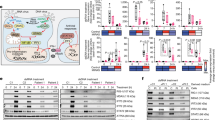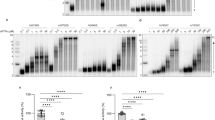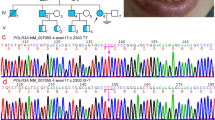Abstract
We reported previously that the DNA polymerase γ (POLG) W748S mutation, a common cause of mitochondrial recessive ataxia syndrome (MIRAS), has a common ancient founder for all the disease chromosomes in Finland, Norway, United Kingdom, and Belgium. Here, we present results showing that the same ancestral chromosome underlies MIRAS and Alpers syndrome in Australia and New Zealand. Furthermore, we show that a second common POLG mutation, A467T, also shows common European ancestry: patients from Australia, New Zealand, and the United States share a common haplotype with the previously reported European patients. These data of ancestral haplotypes indicate that the POLG locus is quite stable and that the recessive W748S and A467T mutations, and probably also G848S, have occurred once in history. They have effectively spread to populations of European descent with carrier frequencies up to 1% in several populations. Our data predict that these mutations are common causes of ataxia and Alpers disease in the Western world.
Similar content being viewed by others
Log in or create a free account to read this content
Gain free access to this article, as well as selected content from this journal and more on nature.com
or
Accession codes
References
Kaguni LS : DNA polymerase gamma, the mitochondrial replicase. Annu Rev Biochem 2004; 73: 293–320.
Longley MJ, Prasad R, Srivastava DK, Wilson SH, Copeland WC : Identification of 5′-deoxyribose phosphate lyase activity in human DNA polymerase gamma and its role in mitochondrial base excision repair in vitro. Proc Natl Acad Sci USA 1998; 95: 12244–12248.
Naviaux RK, Nguyen KV : POLG mutations associated with Alpers' syndrome and mitochondrial DNA depletion. Ann Neurol 2004; 55: 706–712.
Naviaux RK, Nguyen KV : POLG mutations associated with Alpers syndrome and mitochondrial DNA depletion. Ann Neurol 2005; 58: 491.
Ferrari G, Lamantea E, Donati A et al: Infantile hepatocerebral syndromes associated with mutations in the mitochondrial DNA polymerase-gammaA. Brain 2005; 128: 723–731.
Davidzon G, Mancuso M, Ferraris S et al: POLG mutations and Alpers syndrome. Ann Neurol 2005; 57: 921–923.
Nguyen KV, Ostergaard E, Ravn SH et al: POLG mutations in Alpers syndrome. Neurology 2005; 65: 1493–1495.
Nguyen KV, Sharief FS, Chan SS, Copeland WC, Naviaux RK : Molecular diagnosis of Alpers syndrome. J Hepatol 2006; 45: 108–116.
Horvath R, Hudson G, Ferrari G et al: Phenotypic spectrum associated with mutations of the mitochondrial polymerase gamma gene. Brain 2006; 129: 1674–1684.
Rantamaki M, Krahe R, Paetau A, Cormand B, Mononen I, Udd B : Adult-onset autosomal recessive ataxia with thalamic lesions in a Finnish family. Neurology 2001; 57: 1043–1049.
Van Goethem G, Luoma P, Rantamaki M et al: POLG mutations in neurodegenerative disorders with ataxia but no muscle involvement. Neurology 2004; 63: 1251–1257.
Hakonen AH, Heiskanen S, Juvonen V et al: Mitochondrial DNA polymerase W748S mutation: A common cause of autosomal recessive ataxia with ancient european origin. Am J Hum Genet 2005; 77: 430–441.
Winterthun S, Ferrari G, He L et al: Autosomal recessive mitochondrial ataxic syndrome due to mitochondrial polymerase gamma mutations. Neurology 2005; 64: 1204–1208.
Tzoulis C, Engelsen BA, Telstad W et al: The spectrum of clinical disease caused by the A467T and W748S POLG mutations: a study of 26 cases. Brain 2006; 129: 1685–1692.
Van Goethem G, Martin JJ, Dermaut B et al: Recessive POLG mutations presenting with sensory and ataxic neuropathy in compound heterozygote patients with progressive external ophthalmoplegia. Neuromuscul Disord 2003; 13: 133–142.
Van Goethem G, Dermaut B, Lofgren A, Martin JJ, Van Broeckhoven C : Mutation of POLG is associated with progressive external ophthalmoplegia characterized by mtDNA deletions. Nat Genet 2001; 28: 211–212.
Luoma PT, Luo N, Loscher WN et al: Functional defects due to spacer-region mutations of human mitochondrial DNA polymerase in a family with an ataxia-myopathy syndrome. Hum Mol Genet 2005; 14: 1907–1920.
Lamantea E, Tiranti V, Bordoni A et al: Mutations of mitochondrial DNA polymerase gammaA are a frequent cause of autosomal dominant or recessive progressive external ophthalmoplegia. Ann Neurol 2002; 52: 211–219.
Van Goethem G, Lofgren A, Dermaut B, Ceuterick C, Martin JJ, Van Broeckhoven C : Digenic progressive external ophthalmoplegia in a sporadic patient: recessive mutations in POLG and C10orf2/Twinkle. Hum Mutat 2003; 22: 175–176.
Kollberg G, Moslemi AR, Darin N et al: POLG1 mutations associated with progressive encephalopathy in childhood. J Neuropathol Exp Neurol 2006; 65: 758–768.
Varilo T : The age of the mutations in the Finnish disease heritage; a genealogical and linkage disequilibrium study. PhD thesis. National Public Health Institute and University of Helsinki: Helsinki, Finland, 1999.
Price C : Immigration and ethnic origin; in: Australian Historical Statistics. Fairfax, Syme & Weldon: Sydney, Australia, 1987; pp: 2–22.
Khoo S, Lucas D : Australian census analytic program: Australians' ancestries 2001. Cat. no. 2054.0, Australian Bureau of Statistics, Canberra, 2004, p 11.
Ramus SJ, Treacy EP, Cotton RG : Characterization of phenylalanine hydroxylase alleles in untreated phenylketonuria patients from Victoria, Australia: origin of alleles and haplotypes. Am J Hum Genet 1995; 56: 1034–1041.
Pool DI : The Maori Population of New Zealand 1769–1971. Auckland University Press: Auckland, New Zealand, 1977.
Geographica: Suuri maailmankartasto – maanosat, maat, kansat. Könemann, köln, Germany, 2000.
Cossee M, Schmitt M, Campuzano V et al: Evolution of the Friedreich's ataxia trinucleotide repeat expansion: founder effect and premutations. Proc Natl Acad Sci USA 1997; 94: 7452–7457.
Chan SS, Longley MJ, Copeland WC : The common A467T mutation in the human mitochondrial DNA polymerase (POLG) compromises catalytic efficiency and interaction with the accessory subunit. J Biol Chem 2005; 280: 31341–31346.
Acknowledgements
We thank the patients and their family members for their cooperation and also thank the following organizations for financial support: Sigrid Juselius Foundation, University of Helsinki, the Academy of Finland (for AS and AHH), Biomedicum Helsinki Foundation (for AHH), Australian National Health & Medical Research Council (for DRT) and, the Muscular Dystrophy Association and the Marriott Mitochondrial Disorder Clinical Research Fund (for SDM).
Author information
Authors and Affiliations
Corresponding author
Rights and permissions
About this article
Cite this article
Hakonen, A., Davidzon, G., Salemi, R. et al. Abundance of the POLG disease mutations in Europe, Australia, New Zealand, and the United States explained by single ancient European founders. Eur J Hum Genet 15, 779–783 (2007). https://doi.org/10.1038/sj.ejhg.5201831
Received:
Revised:
Accepted:
Published:
Issue date:
DOI: https://doi.org/10.1038/sj.ejhg.5201831
Keywords
This article is cited by
-
Genetic causes of acute encephalopathy in adults: beyond inherited metabolic and epileptic disorders
Neurological Sciences (2022)
-
Clinico-pathological and Molecular Spectrum of Mitochondrial Polymerase γ Mutations in a Cohort from India
Journal of Molecular Neuroscience (2021)
-
POLG-related disorders and their neurological manifestations
Nature Reviews Neurology (2019)
-
Mitochondrial diseases
Nature Reviews Disease Primers (2016)
-
Epidemiological, clinical and biochemical characterization of the p.(Ala359Asp) SMPD1 variant causing Niemann–Pick disease type B
European Journal of Human Genetics (2016)



